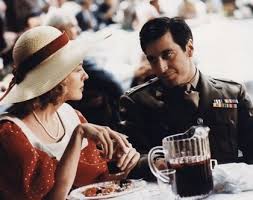Monday, December 6, 2010
Bonasera's Service
Sunday, December 5, 2010
The Sith and the Godfather - Contrast and Compare
Peace is a lie. There is only passion.
Through passion, I gain strength.
Through strength, I gain power.
Through power, I gain victory.
Through victory, my chains are broken.
The Force shall set me free.
-The Sith Code
Though not directly related to any specific events in Coppola's The Godfather Part I, I found this quote and I thought it was quite interesting in relation to it, as well as Joseph Campbell's' concept of the hero's journey. The Sith Code is the moral code of the fictional Sith warriors in George Lucas’ Star Wars saga, in which the Sith represent the forces of ultimate darkness; but as in The Godfather, the audience is shown the softer side of the characters behind it as well. The quote even ties in to the theme of the American Dream and its role in Coppola’s The Godfather, in the idea that through passion and strength, one will gain power, and this power or Force (American Dream), will set the individual free.
Thursday, December 2, 2010
Kay Adams, The Lady in Red

Kay Adams, Michael Corleone’s girlfriend, is characterized throughout the film by always appearing in a red dress; this was identified in the class discussion as the archetype of the “Lady in Red” or “the Scarlet Woman”, and defined as “the Great Mother or the Mother of Abominations, sometimes referred to as the whore of Babalon, her consort is chaos”. I found this last line particularly interesting because it appeared (in the film) just a few scenes before Michael takes the leadership role of the Corleone family after his father is shot. His radical decision to kill the chief of police and sell the story to the reporters is an interesting reference to this and really stuck with me. I like how something so obvious as a woman always wearing a bright red dress (two times is a coincidence, three times is a pattern) can hold such cryptic meanings and even be used as foreshadowing.
Wednesday, December 1, 2010
Corruption and the American Dream in Coppola's The Godfather

The American Dream, the promise of freedom, prosperity and happiness through hard work, the romanticized ideology of capitalism sold to the working class, and the unseen force behind many of the actions of characters actions in Coppola’s The Godfather Part I. Even at the very start of the movie, we are introduced to this notion of the desire to do absolutely anything it takes in order to manifest this idea. Small details in the setting, for example the time period (post-WWII) in which the story occurs, as well as characters like Captain McCluskey, help reinforce the symbolic relationship between the story and the corruption of the American Dream.
The nature of the characters in the film almost acts a foil for the concept of the American Dream and how it has been corrupted by the realities of life in